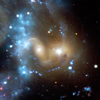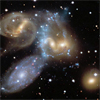CXC Home | Search | Help | Image Use Policy | Latest Images | Privacy | Accessibility | Glossary | Q&A
Tour of Stephan's Quintet
Quicktime MPEG
This beautiful image gives a new look at Stephan's Quintet, a compact group of galaxies discovered about 130 years ago and located about 280 million light years from Earth. A view in optical light from the Canada-France-Hawaii Telescope on Mauna Kea clearly shows four individual galaxies. A fifth, harder-to-see galaxy is plunging its way through the system at almost two million miles per hour. This extreme motion generates a shock wave that heats the gas between the galaxies. This in turn causes the gas to glow strongly in X-rays, and that's detected by the Chandra X-ray Observatory. Stephan's Quintet provides a rare opportunity for astronomers to observe a group of galaxies in a crucial stage of its evolution.
[Runtime: 00:50]
Quicktime MPEG
This beautiful image gives a new look at Stephan's Quintet, a compact group of galaxies discovered about 130 years ago and located about 280 million light years from Earth. A view in optical light from the Canada-France-Hawaii Telescope on Mauna Kea clearly shows four individual galaxies. A fifth, harder-to-see galaxy is plunging its way through the system at almost two million miles per hour. This extreme motion generates a shock wave that heats the gas between the galaxies. This in turn causes the gas to glow strongly in X-rays, and that's detected by the Chandra X-ray Observatory. Stephan's Quintet provides a rare opportunity for astronomers to observe a group of galaxies in a crucial stage of its evolution.
[Runtime: 00:50]
(Credit: X-ray: NASA/CXC/CfA/E. O'Sullivan; Optical: CFHT/Coelum)
Images of Stephan's Quintet
Quicktime MPEG
This sequence begins with the view in optical light of Stephan's Quinet as seen by the Canada-France-Hawaii Telescope on Mauna Kea. The optical image clearly shows four of the galaxies in the group. A fifth, harder-to-see galaxy is plunging its way through the system at almost two million miles an hour. This extreme motion generates a shock wave that heats the gas between the galaxies. This, in turn, causes the gas to glow brightly in X-rays (light blue) that is detected by Chandra.
[Runtime: 00:15]
Quicktime MPEG
This sequence begins with the view in optical light of Stephan's Quinet as seen by the Canada-France-Hawaii Telescope on Mauna Kea. The optical image clearly shows four of the galaxies in the group. A fifth, harder-to-see galaxy is plunging its way through the system at almost two million miles an hour. This extreme motion generates a shock wave that heats the gas between the galaxies. This, in turn, causes the gas to glow brightly in X-rays (light blue) that is detected by Chandra.
[Runtime: 00:15]
(Credit: X-ray: NASA/CXC/CfA/E. O'Sullivan; Optical: CFHT/Coelum)
Return to Stephan's Quintet (July 9, 2009)




